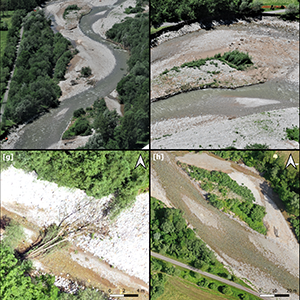Best practices in post-flood surveys: The study case of Pioverna torrent

HTML: 32
All claims expressed in this article are solely those of the authors and do not necessarily represent those of their affiliated organizations, or those of the publisher, the editors and the reviewers. Any product that may be evaluated in this article or claim that may be made by its manufacturer is not guaranteed or endorsed by the publisher.
Authors
Floods cause fatalities and considerable economic damage to infrastructures and settlements, besides impacting fluvial-geomorphic landforms. The increase in the frequency and magnitude of flood events has contributed to inevitably gaining public concern over the flood risk and awareness of the necessity to improve forecasting and monitoring streamflows. In this context, an efficient and systematic procedure of post-event surveys that documents the impacts of a flood event over the territory is often missing. Flood areas delimitation, erosion-sediment variation, and riparian vegetation change are often neglected. The present study shows the field- and desk-based post-flood surveys conducted after an extreme event occurred on June 12th, 2019, along the Pioverna torrent in Valsassina (North Italy). The post-flood surveys consist in collecting meteorological data and time-series satellite images to detect the land cover change (identifying areas covered by water, sediments, and vegetation), and in planning, a few weeks later, an unmanned aerial vehicle (UAV)-based survey to observe the riverbed and streambank change and the modifications in vegetation patterns through high-resolution derived-topographic data. The results show accurate maps of a ground classification from satellite-based elaboration and high-resolution digital elevation models from UAV-based surveys that can support restoration activities and the design of effective countermeasures. This practical application is appropriate and suitable as a river management strategy regarding timing, resources, and economic costs. Thus, standardising the procedure could be essential for creating a historical database, useful to improve specific guidelines and postemergency management strategies.
How to Cite

This work is licensed under a Creative Commons Attribution-NonCommercial 4.0 International License.
PAGEPress has chosen to apply the Creative Commons Attribution NonCommercial 4.0 International License (CC BY-NC 4.0) to all manuscripts to be published.
Similar Articles
- Francesco D' Asaro, Giovanni Grillone, REGIONAL FREQUENCYANALYSIS FOR EXTREME RAINFALL IN SICILY , Journal of Agricultural Engineering: Vol. 39 No. 1 (2008)
- Caiqi Liao, Jin Chen, Fanzhao Geng, Xueming Tang, Airflow basin structure numerical optimisation analysis and suction nozzle characteristics experimental study of vacuum-vibration tray precision seeder , Journal of Agricultural Engineering: Vol. 53 No. 4 (2022)
- Marco Benetti, Franco Gasparini, Andrea Peruzzi, Luigi Sartori, Evaluation of the effects of different openers mounted on no-tillage planters on maize: a field study , Journal of Agricultural Engineering: Vol. 55 No. 3 (2024)
You may also start an advanced similarity search for this article.

 https://doi.org/10.4081/jae.2022.1312
https://doi.org/10.4081/jae.2022.1312






